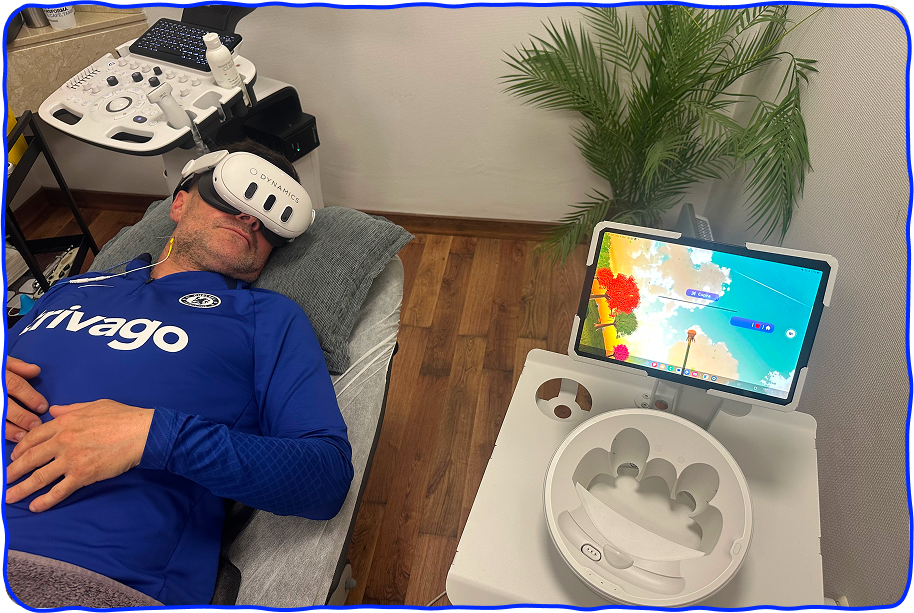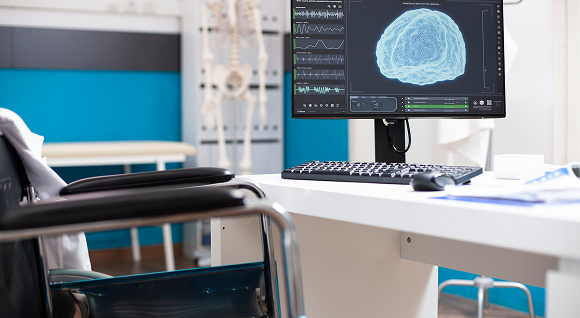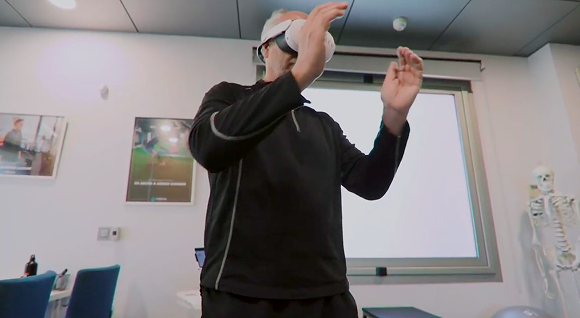Musculoskeletal Rehabilitation with Virtual Reality: Innovation for Physiotherapy Clinics
Dynamics VR – 07/24/2025
Table of Contents
- 1. What is Virtual Reality Rehabilitation?
- 2. Clinical benefits of Virtual Reality in Physical Therapy
- 3. Cases of use in musculoskeletal rehabilitation
- 4. Scientific evidence on the use of Virtual Reality in health care
- 5. Frequently asked questions about VR rehabilitation
- Why choose Dynamics VR in your clinic?
What is Virtual Reality Rehabilitation?
Virtual Reality is a simulated experience with multisensory content (visual, auditory, haptic…) intentionally presented to the individual’s senses (Trost Z et al. 2021). They are systems with the ability to simulate or mimic spatial environments in three dimensions, real or imaginary (Mikropoulos & Natsis, 2011).
Rehabilitation with Virtual Reality consists of the application of this simulation with the aim of helping the patient to recover after his injury, using specific rehabilitation software such as Dynamics VR.
Clinical Benefits of Virtual Reality in Physical Therapy
With Dynamics VR, you will be able to conduct your rehabilitation sessions in a totally innovative and exciting way. Your patients’ movements will be represented by a digital avatar, all in a new and motivating environment.
Immersive Virtual Reality promotes neuroplasticity through repetitive and intentional movements in a relevant context, integrating visual, proprioceptive and spatial processing through mirror neurons (Drakenberg et al. 2023).
When patients see the avatar move as if it were their own body, it stimulates motor learning mechanisms that can modify altered body perception and facilitate new movement patterns.
Main clinical benefits of Virtual Reality:
- Increased range of motion.
- Reduction of kinesiophobia.
- Changes in body perception.
- Improved motor performance.
- Work in enriched and controlled environments.
- Increased patient adherence and motivation.
Musculoskeletal rehabilitation use cases
There are numerous patients who can benefit from the use of immersive virtual reality, especially those seeking to restore motor function and reduce musculoskeletal pain, such as:
- Cervical pain: tendinitis, osteoarthritis, whiplash, hernias, etc.
- Painful shoulder: adhesive capsulitis, tendinopathies, fractures...
- Low back pain: non-specific or specific low back pain with indication of movement.
- Postoperative: ACL, fractures, arthroplasties, etc.
- Invasive therapies: sessions with dry needling, EPI, PENS, neuromodulation...
- Immobilized: isometric work on sprains, casts...
- Patients with chronic pain or fear of movement: Dynamics VR allows them to be gradually exposed to movement without increasing perceived pain.

Scientific evidence on the use of Virtual Reality in health care
Virtual reality has emerged as a promising and increasingly used tool in musculoskeletal rehabilitation, complementing traditional approaches. Current scientific evidence, through clinical studies and systematic reviews, supports its use, although research continues to develop to optimize its application.
1. Increased motivation and motivation and adherence
Many studies indicate that turning rehabilitation tasks into games or challenges promotes greater adherence to treatment. Patients report decreased pain during and after VR therapies, in part due to the distracting effect of immersion in a virtual environment.
2. Improved motor function and physical performance.
In knee and hip arthroplasty, Virtual Reality improves mobility and functionality in the short term (Martínez-Rodríguez, 2020; Lozano-Martínez, 2023). The use of immersive environments such as Dynamics VR facilitates the performance of repetitive and controlled movements in a safe and dynamic environment, which favors a faster recovery and an improvement in range of motion, coordination and balance.
3. Reduction of pain and kinesiophobia.
Virtual Reality has a distracting effect that helps to reduce the perception of pain during the session. In cervicalgia, it has been shown to decrease perceived pain and fear of movement (Sanchez-Herrero et al., 2022). Some studies suggest that VR may be effective in reducing kinesiophobia by providing a safe and controlled environment where patients can experience movement without the associated fear of pain or injury.
Dynamics VR enhances this distracting effect with relaxing environments, music and positive feedback.
4. Specific shoulder cases
Virtual Reality has also been successfully applied in the rehabilitation of musculoskeletal shoulder injuries:
- Improved range and strength (Herrera-Sánchez, 2022).
- Reduction of chronic pain (Calduch Selma, 2020).
- High patient satisfaction with VR rehabilitation (FONDOSCIENCE, 2020).
Frequently asked questions about VR rehabilitation
Which patients can use VR?
Any patient, provided they pass a basic assessment of vision, cognition and motion tolerance. Dynamics VR is designed to accommodate different functional levels.
Does VR have side effects?
In rare cases it may cause dizziness or nausea, which disappear when use is discontinued. Dynamics VR includes safe modes to reduce the likelihood of these effects.
Does it replace conventional physical therapy?
No. Dynamics VR is a complement that accelerates recovery and allows working cognitive and perceptual aspects that are difficult to address only with manual therapy or traditional therapeutic exercise.
Is there specific software for this?
Yes, our PainRehab module is designed to treat cervical, lumbar and shoulder pathology, integrating science, technology and clinical expertise to provide faster and more effective recovery.
Why choose Dynamics VR in your clinic?
Dynamics VR allows you to offer a differential and cutting-edge service in your center. We help you to:
- Automate and monitor the evolution of your patients.
- Personalize treatments according to type of injury and functional level.
- Motivate patients with immersive and gamified experiences.
- Obtain objective progress data (time, range, repetitions...).
- Enhance the loyalty and differentiation of your clinic.

All this with a system that is easy to use, portable and compatible with your daily practice. Do you want your clinic to take a step forward in innovation and clinical results?
Request a demo of Dynamics VR and see the change in your patients.
You may be interested in...

By Dynamics VR l July 24, 2025.
Neurological Rehabilitation with Virtual Reality: Innovation for Physical Therapy Clinics
Discover how virtual reality rehabilitation improves patient recovery. Advanced technology for modern clinics. Read more!
What is Virtual Reality Rehabilitation?…

By Dynamics VR l July 24, 2025.
How does Virtual Reality Rehabilitation work in Physical Therapy?
Explore how VR really works in physiotherapy: technology, sensors and immersive experience. Innovation for your clinic.
Virtual Reality (VR) has revolutionized the physiotherapy field…

